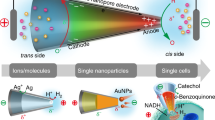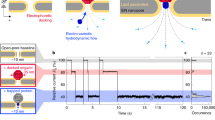Abstract
Outer membrane vesicles (OMVs) are extracellular structures derived from the outer membrane of bacteria. They carry diverse cargos such as proteins, nucleic acids and enzymes, which are released by bacteria to communicate with each other and with host cells. Understanding the role of OMVs as carriers of signalling enzymes provides insights into intercellular communication, pathogenesis and biofilm formation, among others. Although fluorescence-based techniques have been employed to study vesicles, real-time live monitoring of enzyme-based cellular communication has remained challenging due to undesired effects of photobleaching and interference from labelling agents. Here we report label-free dynamic monitoring of the oscillatory activity of the enzyme azoreductase (AzoR) in individual live bacteria via nanoplasmonic optical antennas. Our nanoplasmonic antennas consist of gold nanorods modified with black hole quencher molecules (BHQ-3), whose scattering cross-section is modulated by the presence of AzoR. The antennas enable long-term (several hours) and distance-dependent (up to 3 μm) detection of AzoR via OMVs released by individual live bacteria. We observe periodic oscillatory enzyme activity in different living environments and at different stages of bacterial growth. We also found that oscillatory enzyme activity exhibits heterogeneous features due to the coupling of oscillation signals between neighbouring bacteria. The dynamic monitoring of signalling enzymes paves the way for a better understanding of mechanisms of bacterial communication, pathogenesis and drug resistance.
This is a preview of subscription content, access via your institution
Access options
Access Nature and 54 other Nature Portfolio journals
Get Nature+, our best-value online-access subscription
$29.99 / 30 days
cancel any time
Subscribe to this journal
Receive 12 print issues and online access
$209.00 per year
only $17.42 per issue
Buy this article
- Purchase on Springer Link
- Instant access to full article PDF
Prices may be subject to local taxes which are calculated during checkout




Similar content being viewed by others
Data availability
All of the data that support the findings of this study are reported in the main text and Supplementary Information. Source Data are available from the corresponding authors upon reasonable request.
References
Kaparakis-Liaskos, M. & Ferrero, R. L. Immune modulation by bacterial outer membrane vesicles. Nat. Rev. Immunol. 15, 375–387 (2015).
Wang, X., Thompson, C. D., Weidenmaier, C. & Lee, J. C. Release of Staphylococcus aureus extracellular vesicles and their application as a vaccine platform. Nat. Commun. 9, 1379 (2018).
Yuan, J. et al. Safe Staphylococcal platform for the development of multivalent nanoscale vesicles against viral infections. Nano Lett. 18, 725–733 (2018).
Phan, N. T. N., Li, X. & Ewing, A. G. Measuring synaptic vesicles using cellular electrochemistry and nanoscale molecular imaging. Nat. Rev. Chem. 1, 0048 (2017).
Verweij, F. J. et al. The power of imaging to understand extracellular vesicle biology in vivo. Nat. Meth. 18, 1013–1026 (2021).
Poskanzer, K. E., Marek, K. W., Sweeney, S. T. & Davis, G. W. Synaptotagmin I is necessary for compensatory synaptic vesicle endocytosis in vivo. Nature 426, 559–563 (2003).
Pasquina-Lemonche, L. et al. The architecture of the Gram-positive bacterial cell wall. Nature 582, 294–297 (2020).
Alsteens, D., Trabelsi, H., Soumillion, P. & Dufrene, Y. F. Multiparametric atomic force microscopy imaging of single bacteriophages extruding from living bacteria. Nat. Commun. 4, 2926 (2013).
Fantner, G. E., Barbero, R. J., Gray, D. S. & Belcher, A. M. Kinetics of antimicrobial peptide activity measured on individual bacterial cells using high-speed atomic force microscopy. Nat. Nanotechnol. 5, 280–285 (2010).
Benn, G., Pyne, A. L. B., Ryadnov, M. G. & Hoogenboom, B. W. Imaging live bacteria at the nanoscale: comparison of immobilisation strategies. Analyst 144, 6944–6952 (2019).
Valencia-Burton, M., McCullough, R. M., Cantor, C. R. & Broude, N. E. RNA visualization in live bacterial cells using fluorescent protein complementation. Nat. Meth. 4, 421–427 (2007).
Ma, Y. et al. A FRET sensor enables quantitative measurements of membrane charges in live cells. Nat. Biotechnol. 35, 363–370 (2017).
Boden, A. et al. Volumetric live cell imaging with three-dimensional parallelized RESOLFT microscopy. Nat. Biotechnol. 39, 609–618 (2021).
Gahlmann, A. & Moerner, W. E. Exploring bacterial cell biology with single-molecule tracking and super-resolution imaging. Nat. Rev. Microbiol. 12, 9–22 (2014).
Farrell, M. V. et al. Protein-PAINT: superresolution microscopy with signaling proteins. Sci. Signal. 15, eabg9782 (2022).
Kimura, T. et al. Imaging live cell in micro-liquid enclosure by X-ray laser diffraction. Nat. Commun. 5, 3052 (2014).
Stevenson, T. J. Epigenetic regulation of biological rhythms: an evolutionary ancient molecular timer. Trends Genet. 34, 90–100 (2018).
Leng, N. et al. Oscope identifies oscillatory genes in unsynchronized single-cell RNA-seq experiments. Nat. Meth. 12, 947–950 (2015).
Rust, M. J., Golden, S. S. & O’Shea, E. K. Light-driven changes in energy metabolism directly entrain the cyanobacterial circadian oscillator. Science 331, 220–223 (2011).
Patke, A., Young, M. W. & Axelrod, S. Molecular mechanisms and physiological importance of circadian rhythms. Nat. Rev. Mol. Cell Biol. 21, 67–84 (2020).
Martí Ruiz, M. C. et al. Circadian oscillations of cytosolic free calcium regulate the Arabidopsis circadian clock. Nat. Plants 4, 690–698 (2018).
Lamia, K. A. et al. AMPK regulates the circadian clock by cryptochrome phosphorylation and degradation. Science 326, 437–440 (2009).
Oh, G. et al. Cytosine modifications exhibit circadian oscillations that are involved in epigenetic diversity and aging. Nat. Commun. 9, 644 (2018).
Quirk, C. R. et al. Precisely timed theta oscillations are selectively required during the encoding phase of memory. Nat. Neurosci. 24, 1614–1627 (2021).
Raj, A. & Van Oudenaarden, A. Nature, nurture, or chance: stochastic gene expression and its consequences. Cell 135, 216–226 (2008).
Dundas, A. A. et al. Validating a predictive structure–property relationship by discovery of novel polymers which reduce bacterial biofilm formation. Adv. Mater. 31, 1903513 (2019).
Lenz, P. & Sogaard-Andersen, L. Temporal and spatial oscillations in bacteria. Nat. Rev. Microbiol. 9, 565–577 (2011).
Jenal, U., Reinders, A. & Lori, C. Cyclic di-GMP: second messenger extraordinaire. Nat. Rev. Microbiol. 15, 271–284 (2017).
Smits, W. K., Kuipers, O. P. & Veening, J. W. Phenotypic variation in bacteria: the role of feedback regulation. Nat. Rev. Microbiol. 4, 259–271 (2006).
Waters, C. M. & Bassler, B. L. Quorum sensing: cell-to-cell communication in bacteria. Annu. Rev. Cell Dev. Biol. 21, 319–346 (2005).
Moradali, M. F. & Rehm, B. H. Bacterial biopolymers: from pathogenesis to advanced materials. Nat. Rev. Microbiol. 18, 195–210 (2020).
Pei, J. F. et al. Diurnal oscillations of endogenous H2O2 sustained by p66Shc regulate circadian clocks. Nat. Cell Biol. 21, 1553–1564 (2019).
Nie, L. et al. Dual-site fluorescent probe to monitor intracellular nitroxyl and GSH-GSSG oscillations. Anal. Chem. 91, 4451–4456 (2019).
Etter, G. et al. Optogenetic gamma stimulation rescues memory impairments in an Alzheimer’s disease mouse model. Nat. Commun. 10, 5322 (2019).
Zutshi, I. et al. Hippocampal neural circuits respond to optogenetic pacing of theta frequencies by generating accelerated oscillation frequencies. Curr. Biol. 28, 1179–1188 (2018).
Wang, S. W. & Tang, L. H. Emergence of collective oscillations in adaptive cells. Nat. Commun. 10, 5613 (2019).
Ye, W. et al. Plasmonic nanosensors reveal a height dependence of MinDE protein oscillations on membrane features. J. Am. Chem. Soc. 140, 17901–17906 (2018).
Xin, H., Namgung, B. & Lee, L. P. Nanoplasmonic optical antennas for life sciences and medicine. Nat. Rev. Mater. 3, 228–243 (2018).
Liu, G. L., Long, Y. T., Choi, Y., Kang, T. & Lee, L. P. Quantized plasmon quenching dips nanospectroscopy via plasmon resonance energy transfer. Nat. Meth. 4, 1015–1017 (2007).
Anker, J. N. et al. Biosensing with plasmonic nanosensors. Nat. Meth. 7, 442–453 (2008).
Xin, H. et al. Quantum biological tunnel junction for electron transfer imaging in live cells. Nat. Commun. 10, 3245 (2019).
Tsargorodska, A. et al. Strong coupling of localized surface plasmons to excitons in light-harvesting complexes. Nano Lett. 16, 6850–6856 (2016).
Misal, S. A. & Gawai, K. R. Azoreductase: a key player of xenobiotic metabolism. Bioresour. Bioprocess. 5, 17 (2018).
Tian, Y. et al. In-situ imaging of azoreductase activity in the acute and chronic ulcerative colitis mice by a near-infrared fluorescent probe. Anal. Chem. 91, 10901–10907 (2019).
Qing, G. et al. Natural and engineered bacterial outer membrane vesicles. Biophys. Rep. 5, 184–198 (2019).
Schwechheimer, C. & Kuehn, M. J. Outer-membrane vesicles from Gram-negative bacteria: biogenesis and functions. Nat. Rev. Microbiol. 13, 605–619 (2015).
Salvachúa, D. et al. Outer membrane vesicles catabolize lignin-derived aromatic compounds in Pseudomonas putida KT2440. Proc. Natl Acad. Sci. USA 117, 9302–9310 (2020).
Kulp, A. & Kuehn, M. J. Biological functions and biogenesis of secreted bacterial outer membrane vesicles. Annu. Rev. Microbiol. 64, 163 (2010).
Mittelbrunn, M. & Sánchez-Madrid, F. Intercellular communication: diverse structures for exchange of genetic information. Nat. Rev. Mol. Cell Biol. 13, 328–335 (2012).
Koslov, M. M. & Markin, V. S. A theory of osmotic lysis of lipid vesicles. J. Theor. Biol. 109, 17–39 (1984).
Zhao, X. et al. In situ single-cell surgery and intracellular organelle manipulation via thermoplasmonics combined optical trapping. Nano Lett. 1, 402–410 (2021).
Vogel, S., Tank, M. & Goodyear, N. Variation in detection limits between bacterial growth phases and precision of an ATP bioluminescence system. Lett. Appl. Microbiol. 58, 370–375 (2014).
Segall-Shapiro, T. H., Sontag, E. D. & Voigt, C. A. Engineered promoters enable constant gene expression at any copy number in bacteria. Nat. Biotechnol. 36, 352–358 (2018).
Roier, S. et al. A novel mechanism for the biogenesis of outer membrane vesicles in Gram-negative bacteria. Nat. Commun. 7, 10515 (2016).
Ito, K. et al. Three-dimensional structure of AzoR from Escherichia coli: an oxidereductase conserved in microorganisms. J. Biol. Chem. 281, 20567–20576 (2006).
Acknowledgements
This work was supported by the National Natural Science Foundation of China (grant nos. 62135005, 61975065, 32271405 and 12204196 to B.L., H.X., T.P. and Y.S., respectively), Guangdong Basic and Applied Basic Research Foundation (grant no. 2022B1515120012 to H.X.) and Science and Technology Program of Guangzhou (grant no. 202201010370 to T.P.).
Author information
Authors and Affiliations
Contributions
H.X. and L.P.L. conceptualized the work, D.L., B.L. and H.X. designed the study. D.L., G.Z., D.W., J.X. and T.P. performed the experiments. Y.S. and X.L. performed simulations. D.L., B.L., H.X. and L.P.L. wrote the paper. All the authors contributed to the data analysis, discussion and manuscript preparation.
Corresponding authors
Ethics declarations
Competing interests
The authors declare no competing interests.
Peer review
Peer review information
Nature Photonics thanks Shaopeng Wang and the other, anonymous, reviewer(s) for their contribution to the peer review of this work.
Additional information
Publisher’s note Springer Nature remains neutral with regard to jurisdictional claims in published maps and institutional affiliations.
Supplementary information
Supplementary Information
Supplementary Figs. 1–25, Notes 1–4 and refs. 1–9.
Supplementary Video
Video showing the measurement for a single bacterium.
Rights and permissions
Springer Nature or its licensor (e.g. a society or other partner) holds exclusive rights to this article under a publishing agreement with the author(s) or other rightsholder(s); author self-archiving of the accepted manuscript version of this article is solely governed by the terms of such publishing agreement and applicable law.
About this article
Cite this article
Lu, D., Zhu, G., Li, X. et al. Dynamic monitoring of oscillatory enzyme activity of individual live bacteria via nanoplasmonic optical antennas. Nat. Photon. 17, 904–911 (2023). https://doi.org/10.1038/s41566-023-01265-2
Received:
Accepted:
Published:
Issue Date:
DOI: https://doi.org/10.1038/s41566-023-01265-2



